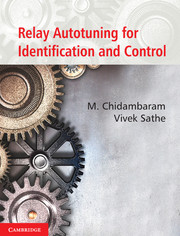Book contents
- Frontmatter
- Contents
- List of Figures
- List of Tables
- Acknowledgements
- Preface
- 1 Introduction
- 2 Improved Autotune Identification Methods
- 3 Cascade Controllers Tuning by Relay Autotune Method
- 4 Simultaneous Relay Autotuning of Cascade Controllers
- 5 A Simple Method of Tuning Cascade Controllers
- 6 Improved Saturation Relay Test for Systems with Large Dead Time
- 7 Identification of FOPTD Model using Single Symmetrical Relay Test
- 8 Autotuning of PID Controllers for Unstable FOPTD Systems
- 9 Autotuning of PID Controllers for Critically Damped SOPTD Systems
- 10 Estimation of SOPTD Transfer Function Model
- 11 Estimation of Five Parameters of Unstable SOPTD Model with a Zero
- 12 Identification of FOPTD Multivariable Systems
- 13 Identification of SOPTD Multivariable Systems
- 14 Tuning of Multivariable Controllers for Non-Minimum Phase Systems
- 15 Tuning of Multivariable Controllers by Genetic Algorithms
- 16 Summary and Conclusions
- Appendix A
- Appendix B
- Appendix C
- Nomenclature
- Problems
- Suggestive Reading
- References
- Index
13 - Identification of SOPTD Multivariable Systems
Published online by Cambridge University Press: 05 June 2014
- Frontmatter
- Contents
- List of Figures
- List of Tables
- Acknowledgements
- Preface
- 1 Introduction
- 2 Improved Autotune Identification Methods
- 3 Cascade Controllers Tuning by Relay Autotune Method
- 4 Simultaneous Relay Autotuning of Cascade Controllers
- 5 A Simple Method of Tuning Cascade Controllers
- 6 Improved Saturation Relay Test for Systems with Large Dead Time
- 7 Identification of FOPTD Model using Single Symmetrical Relay Test
- 8 Autotuning of PID Controllers for Unstable FOPTD Systems
- 9 Autotuning of PID Controllers for Critically Damped SOPTD Systems
- 10 Estimation of SOPTD Transfer Function Model
- 11 Estimation of Five Parameters of Unstable SOPTD Model with a Zero
- 12 Identification of FOPTD Multivariable Systems
- 13 Identification of SOPTD Multivariable Systems
- 14 Tuning of Multivariable Controllers for Non-Minimum Phase Systems
- 15 Tuning of Multivariable Controllers by Genetic Algorithms
- 16 Summary and Conclusions
- Appendix A
- Appendix B
- Appendix C
- Nomenclature
- Problems
- Suggestive Reading
- References
- Index
Summary
In this chapter, the method discussed in Chapter 10 on identifying second order plus time delay (SOPTD) transfer function models by asymmetric relay tuning method is extended to identify a multivariable system. The decentralized relay feedback method suggested by Wang et al. (1997) is applied for the m × m system and m relay tests are required for identifying the entire transfer function matrix. Although most of the processes can be adequately approximated by a first order plus time delay (FOPTD) model, some of the processes are under-damped and higher order processes can be better incorporated by an SOPTD than an FOPTD model. Certain higher order stable models when approximated to an FOPTD model give a negative time constant, hence, identifying a second order model is necessary. The proposed method (Ganesh and Chidambaram, 2005) is applied to a 2 × 2 transfer function matrix. Multivariable IMC controllers are designed for the identified model and the closed loop performances of the actual and identified models are compared.
Introduction
As stated earlier in Chapter 2, Srinivasan and Chidambaram (2004) proposed a method to analyze the conventional relay autotune data for estimating the three parameters of the FOPTD model using only one relay experiment. They proposed an additional equation, which along with the phase angle and amplitude criteria gives three parameters. Srinivasan and Chidambaram (2003) also proposed a modified asymmetrical relay feedback method to get improved estimates of the parameters of the FOPTD model.
- Type
- Chapter
- Information
- Relay Autotuning for Identification and Control , pp. 174 - 182Publisher: Cambridge University PressPrint publication year: 2014



